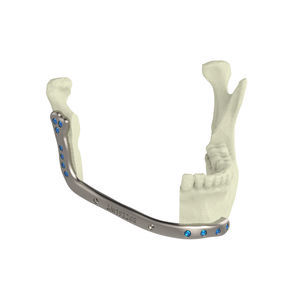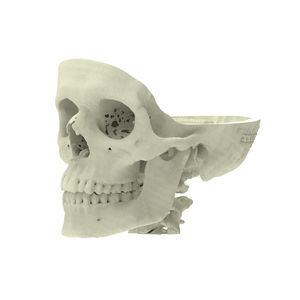
Custom-made periorbital implant non-absorbable
Add to favorites
Compare this product
Characteristics
- Type of implant
- custom-made
- Resorbability
- non-absorbable
Description
Orbital wall fractures can result in increased orbital volume, tissue herniation into the maxillary sinus, fat atrophy, loss of ligament support, and scar contracture leading to enophthalmos and diplopia. Reconstruction of large defects remains challenging since anatomical landmarks are lost, particularly the posteromedial orbital bulge and orbital apex.
Two Piece Orbital Floor
Unfortunately nowadays standard pre bend meshes are used and often leave unsatisfied results.
PSI placement over failed pre bend mesh
To design implants for orbital reconstruction, rapid prototype models can be derived from Digital Imaging and Communications in Medicine (DICOM) data obtained from the patient’s computed tomography (CT) scan. The model is used to create the implant by mirroring data from the unaffected orbit, and reconstruction is performed with prebent plates. Although this technique is not commonly used, advantages include a true-to-original anatomical repair, restoration of orbital volume, and superior ophthalmological rehabilitation when evaluating for binocular single vision and ocular motility. From a surgical point of view, insertion is simplified by the precise fit, and no operating time is wasted in shaping the implant.
Mirror Orbital Floor
Left orbit was used to reconstruct the orbital floor on the defect side.
Lateral patient specific implant
Lateral implant placement.
Medial patient specific implant
The puzzle-like interlocking of the implant pieces allows unambiguous anteroposterior positioning of one piece relative to the other. Overlapping edges of the connection provide an interlock in the coronal plane,
Catalogs
No catalogs are available for this product.
See all of Xilloc‘s catalogsRelated Searches
- Bone plate
- Compression plate
- Interbody fusion cage
- PEEK interbody fusion cage
- Lumbar interbody fusion cage
- Titanium interbody fusion cage
- General purpose compression plate
- Transforaminal interbody fusion cage
- Cranial implant
- Custom-made cranial implant
- Periorbital implant
- Custom-made periorbital implant
- Non-absorbable periorbital implant
- Non-absorbable mandibular implant
- Custom-made mandibular implant
- Custom-made temporomandibular implant
- Temporomandibular implant
*Prices are pre-tax. They exclude delivery charges and customs duties and do not include additional charges for installation or activation options. Prices are indicative only and may vary by country, with changes to the cost of raw materials and exchange rates.








